Newsletter Volume 10, Issue 2 June 2025
Event Report
Outcomes of the First IPA Seminar on Press-in Technology in Tunisia
Outcomes of the First IPA Seminar on Press-in Technology in Tunisia
Introduction
The International Press-in Association (IPA) successfully hosted its inaugural seminar in Tunisia on April 4th, 2025, at the Le Royal Hammamet Hotel. This historic event marked the first IPA seminar organized in Africa, underscoring the expanding global reach and application of press-in piling technology. Attended by over fifty participants from seven countries—Egypt, Japan, Luxembourg, Madagascar, Netherlands, Tunisia, and the United Kingdom—the seminar featured eight oral presentations and one video presentation, highlighting a diversity of perspectives and innovations in press-in piling technology.
Through the seminar’s diverse presentations and active discussions, a number of shared values and forward-looking directions emerged—such as the integration of design and construction, data-informed engineering, sustainable development, and international collaboration for regional adaptation.
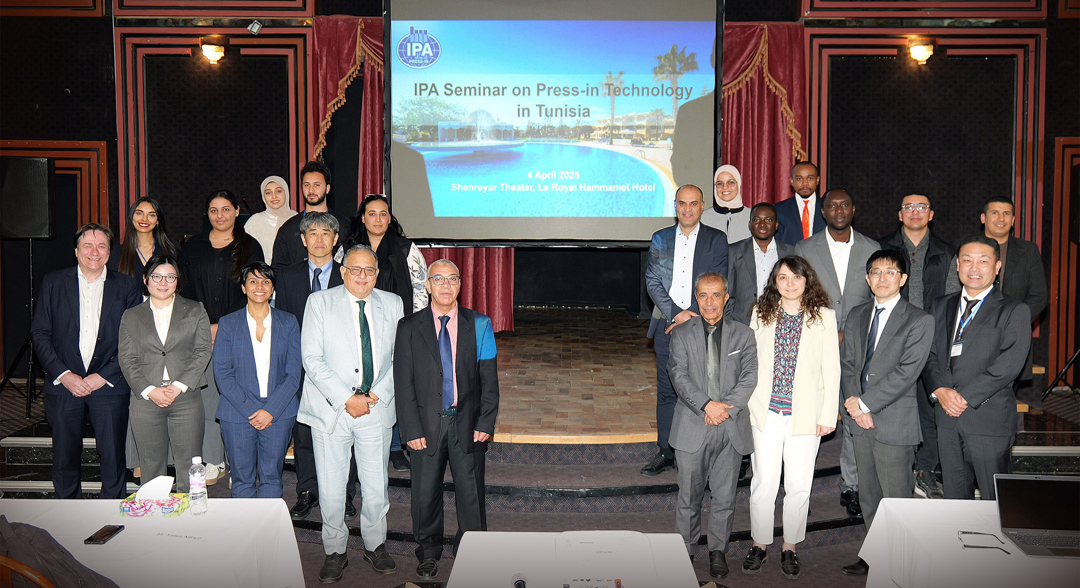
Objective
The seminar aimed to promote the press-in piling technology, a pioneering approach in civil engineering, and to introduce the second edition of the "Press-in Retaining Structures: A Handbook." This gathering served as a platform for discussing the methodology’s applications and innovations in construction, particularly under the challenging conditions often found in African environments. It sought to increase awareness and facilitate technology transfer, improving the understanding of the interaction mechanisms between the ground and structures within the region.
Attendance and Participation
The event was attended by 55 delegates including researchers, practitioners, and students from across the region. The seminar featured comprehensive presentations and discussions led by esteemed members of the press-in engineering community and local experts.
Program Highlights
The seminar featured a series of opening and technical presentations by distinguished speakers. Below is a detailed summary of each session:
Opening Remarks – Prof. Mounir Bouassida
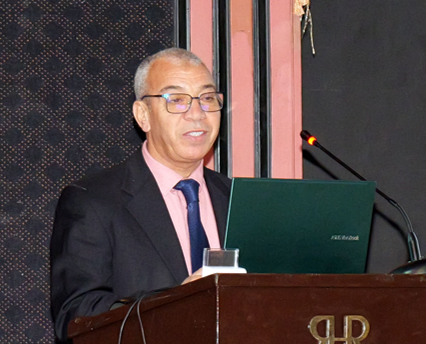 The seminar commenced with opening remarks by Professor Mounir Bouassida, Vice President of IPA and the Honorary Chair of the seminar. He welcomed participants on behalf of Africa and shared the background leading up to this historic event—the first IPA seminar on the continent. Prof. Bouassida traced his involvement with the IPA since 2017, when he became the first African geotechnical engineer to serve on the IPA Board.
The seminar commenced with opening remarks by Professor Mounir Bouassida, Vice President of IPA and the Honorary Chair of the seminar. He welcomed participants on behalf of Africa and shared the background leading up to this historic event—the first IPA seminar on the continent. Prof. Bouassida traced his involvement with the IPA since 2017, when he became the first African geotechnical engineer to serve on the IPA Board.He highlighted his contributions to IPA activities, including the review of ICPE (International Conference on Press-in Engineering) papers, authorship in the IPA Newsletter, and collaboration on French and Arabic translations of the Press-in Handbook.
In his remarks, he also outlined the early adoption of press-in piling technologies in Africa, citing case histories in South Africa, Egypt, and Senegal. He explained how Tunisia was selected as the host country for the seminar, following consultations with JICA (Japan International Cooperation Agency) and consideration of geographical accessibility within North Africa. He concluded by acknowledging the support of local and international partners—Tunisian Engineers Order, International Society for Soil Mechanics and Geotechnical Engineering (ISSMGE), Japan International Cooperation Agency (JICA), Geotechnical Engineering and GeoRisk Laboratory, SIMPRO Tunisia—as well as the seminar’s three gold sponsors: ArcelorMittal Sheet Piling, GIKEN LTD. and GIKEN SEKO CO., LTD.
Welcome Address – Mr. Kamel Sahnoun
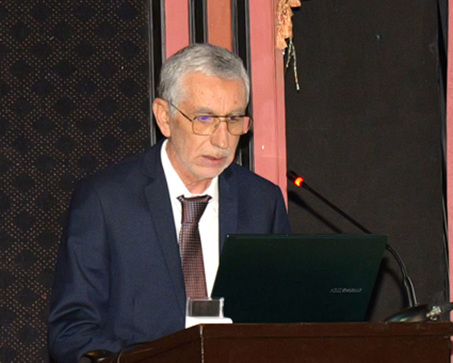 Following the opening remarks, Mr. Kamel Sahnoun, President of the Tunisian Engineers Order, one of the seminar’s supporting organizations, gave a welcome address on behalf of the national engineering body. Speaking in French, he expressed appreciation for IPA’s choice of Tunisia as the host country, highlighting the nation's stability, its rich base of engineering talent, and its strategic role as a connector between Africa and the wider global community.
Following the opening remarks, Mr. Kamel Sahnoun, President of the Tunisian Engineers Order, one of the seminar’s supporting organizations, gave a welcome address on behalf of the national engineering body. Speaking in French, he expressed appreciation for IPA’s choice of Tunisia as the host country, highlighting the nation's stability, its rich base of engineering talent, and its strategic role as a connector between Africa and the wider global community.In his speech, Mr. Sahnoun acknowledged the symbolic importance of the seminar coinciding with the release of the second edition of the Press-in Retaining Structures: A Handbook, now available in English, French, and Arabic. He emphasized Tunisia's readiness to contribute to sustainable infrastructure through innovation, technical mastery, and international collaboration.
He conveyed three core messages: (1) the importance of strengthening the “virtuous triangle” of industry, scientific research, and government regulation; (2) the proactive role of Tunisian engineers in adapting press-in piling techniques to local soil conditions and training future geotechnical experts; and (3) Tunisia’s growing engagement across Africa, where its engineers have contributed to infrastructure development in numerous countries.
His remarks concluded with a vision for a new era in Tunisian geotechnical engineering—one that combines technical excellence with environmental stewardship.
Presentation 1: The Prospect of IPA – Dr. Jiro Takemura
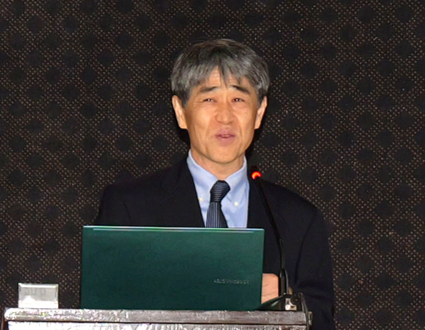 The first technical presentation was delivered by Dr. Jiro Takemura, Vice President of the IPA. His presentation, titled “The Prospect of IPA”, provided an overarching view of IPA’s academic mission, technological scope, and global outreach. Dr. Takemura introduced the concept of press-in engineering as a multidisciplinary field that integrates geotechnical, environmental, mechanical, and monitoring engineering with data-driven analysis.
The first technical presentation was delivered by Dr. Jiro Takemura, Vice President of the IPA. His presentation, titled “The Prospect of IPA”, provided an overarching view of IPA’s academic mission, technological scope, and global outreach. Dr. Takemura introduced the concept of press-in engineering as a multidisciplinary field that integrates geotechnical, environmental, mechanical, and monitoring engineering with data-driven analysis.He explained how IPA, since its foundation in 2007 at Cambridge University, has served as a global academic platform for knowledge exchange, standardization, and innovation in press-in piling technologies.
The talk highlighted IPA’s core activities—ranging from the publication of multilingual technical manuals, such as the Press-in Handbook, to its research-oriented Technical Committees (TCs), which address topics from seismic performance to data-driven soil characterization.
He also emphasized the Five Construction Principles—environment, safety, speed, economy, and aesthetics—as foundational to the press-in piling technology, and presented case studies of successful applications in urban infrastructure, disaster recovery, and emergency response across Europe, Africa, Asia, and the Americas.
Dr. Takemura concluded by introducing the Press-in Piling Total System (PPTS) as a tool for real-time optimization and intelligent soil estimation, underscoring IPA’s commitment to harmonizing innovation with practical engineering needs and societal challenges.
Presentation 2: Press-in Retaining Structures: A Handbook (Construction) – Mr. Ndoye Yahya
 Mr. Ndoye Yahya from Giken Europe B.V. delivered a presentation focused on Chapter 4: “Construction Guidelines” from the Press-in Retaining Structures: A Handbook. Drawing on the GIKEN Group’s extensive field experience and the latest knowledge compiled in the Handbook, he provided a practical and systematic explanation of the press-in piling process.
Mr. Ndoye Yahya from Giken Europe B.V. delivered a presentation focused on Chapter 4: “Construction Guidelines” from the Press-in Retaining Structures: A Handbook. Drawing on the GIKEN Group’s extensive field experience and the latest knowledge compiled in the Handbook, he provided a practical and systematic explanation of the press-in piling process.He began by introducing the SILENT PILER™, the core machinery of the press-in method, explaining its operational principles, including self-walking functionality and reaction force mechanisms that rely on pre-installed piles. These features ensure minimal noise, low vibration, and reduced environmental impact.
The presentation covered the various types of applicable piles such as U, Z, hat, and tubular piles, and described the penetration techniques suitable for different ground conditions, including standard press-in, water jetting, augering, and the Gyropress Method™ (rotary press-in method).
He also highlighted the non-staging construction approach—featuring equipment such as the clamping crane—as an effective solution for urban and space-constrained environments. This was followed by international case studies demonstrating the advantages of press-in piling technology.
International examples included a port terminal renovation in Senegal using tubular piles and the Gyropress Method above water, foundation works for medical facilities in Egypt utilizing zero clearance techniques, and sewer installation in South Africa carried out with minimal disturbance to underground infrastructure. In Europe, the method was used for quay wall renovation in Amsterdam’s World Heritage-listed canals. Additional applications in Thailand, India, Japan, Brazil, and Singapore showcased its versatility in flood control, emergency recovery, and deep foundation solutions under complex conditions.
These diverse examples underscored the adaptability of the press-in method, demonstrating its potential for safe, precise, and environmentally considerate construction worldwide.
Presentation 3: Estimating soil and rock failure parameters from the Press-in data – Prof. Mounir Bouassida
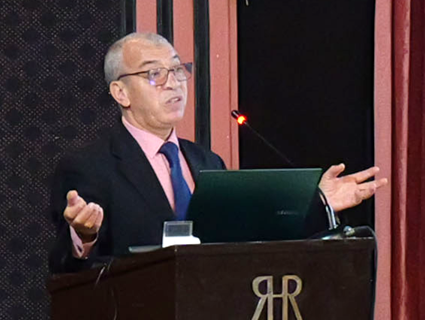 Prof. Mounir Bouassida of the University of Tunis El Manar presented a technical study on estimating soil and rock failure parameters using press-in data. Drawing on his own analytical framework and referencing a study case introduced in the Press-in Retaining Structures: A Handbook, he demonstrated how press-in monitoring data can be utilized to derive geotechnical strength parameters directly.
Prof. Mounir Bouassida of the University of Tunis El Manar presented a technical study on estimating soil and rock failure parameters using press-in data. Drawing on his own analytical framework and referencing a study case introduced in the Press-in Retaining Structures: A Handbook, he demonstrated how press-in monitoring data can be utilized to derive geotechnical strength parameters directly.He began by reviewing conventional indirect methods—such as in-situ tests like SPT, CPT, and pressuremeter tests—that estimate shear strength through empirical correlations, noting their limitations in accuracy and dependence on site-specific conditions. As an alternative, he introduced the Cylindrical Shear Tool (CST), a physical model that replicates pile-soil interaction and provides measurable load and torque values.
Prof. Bouassida drew an analogy between the CST and full-scale tubular steel piles, proposing a method to estimate undrained cohesion (Su) and friction angle (ϕ) using recorded press-in force and torque-rotation data. His analytical model incorporated practical engineering assumptions, enabling a simplified and realistic estimation of failure parameters based on press-in data.
He presented results showing reasonable agreement between CST-based estimates and traditional direct shear tests. His findings suggest that the press-in method, when combined with observational modeling, can contribute meaningfully to in-situ geotechnical characterization. He concluded by emphasizing the need for further validation and the potential for broader application through international collaboration.
Presentation 4: Press-in Retaining Structures: A Handbook, Second Edition – Chapter 3: Design Guidelines – Dr. Jignasha Panchal
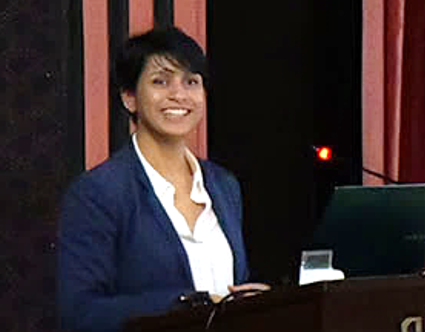 Dr. Jignasha Panchal, Director of the IPA and Engineering Manager at A2 Advanced Monitoring, delivered a presentation introducing Chapter 3: Design Guidelines from Press-in Retaining Structures: A Handbook, Second Edition. Her lecture outlined the design principles and methodologies for embedded cantilever retaining walls, emphasizing performance-based design approaches and their practical application.
Dr. Jignasha Panchal, Director of the IPA and Engineering Manager at A2 Advanced Monitoring, delivered a presentation introducing Chapter 3: Design Guidelines from Press-in Retaining Structures: A Handbook, Second Edition. Her lecture outlined the design principles and methodologies for embedded cantilever retaining walls, emphasizing performance-based design approaches and their practical application.She began by highlighting the dual importance of global harmonization and local adaptation in geotechnical design. Drawing from global infrastructure experience and regional conditions such as seismicity and climate, she explained how the Handbook aligns with major international standards—including Eurocode 7, ISO 2394, Japan’s Geocode-21, and AASHTO LRFD.
Dr. Panchal described the application of limit state design, including the serviceability limit state, reparability limit state, and ultimate limit state, and explained how these are considered under various design situations such as persistent, transient, or accidental conditions. She also reviewed design factors like embedded depth determination, excavation bottom stability, and overall foundation safety.
In the latter part of the presentation, Dr. Panchal explained how Distributed Fibre Optic Sensing (DFOS) technology can be integrated into retaining structures for advanced monitoring. Compared with conventional inclinometers, DFOS enables continuous measurement of strain and temperature along the structure, allowing for more detailed assessment of displacement gradients and curvature.
She concluded by emphasizing that instrumentation and monitoring not only enhance safety but also allow for design refinement and feedback into future projects—supporting the evolving concept of press-in engineering as a data-informed and performance-driven discipline.
Presentation 5: LES FONDATIONS PROFONDES – RETOURS D’EXPERIENCE (Deep Foundations – Feedback from Field Experience) – Mr. Mohamed Trabelsi
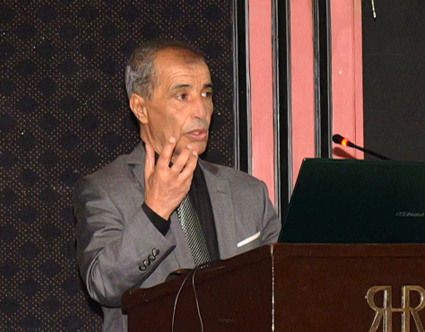 Mr. Mohamed Trabelsi, Senior Civil Engineer and representative of the Tunisian Engineers Order—one of the seminar’s supporting organizations—delivered a presentation in French on deep foundation engineering, stepping in for the originally scheduled speaker, Mr. Makram Guitouni. Drawing on his extensive field experience across Africa, Mr. Trabelsi provided a professional perspective on traditional foundation techniques and their relevance to press-in piling technologies.
Mr. Mohamed Trabelsi, Senior Civil Engineer and representative of the Tunisian Engineers Order—one of the seminar’s supporting organizations—delivered a presentation in French on deep foundation engineering, stepping in for the originally scheduled speaker, Mr. Makram Guitouni. Drawing on his extensive field experience across Africa, Mr. Trabelsi provided a professional perspective on traditional foundation techniques and their relevance to press-in piling technologies.The presentation included examples of traditional deep foundation techniques, such as vibro-driven sheet piles and rotary bored piles, which are often employed in constrained or soft ground conditions. These examples served as a contrast to press-in piling technologies, highlighting the operational challenges—such as noise, vibration, and soil disturbance—typically associated with conventional methods.
Mr. Trabelsi then introduced the SILENT PILER as a technologically advanced alternative. He emphasized its key advantages, including quiet and vibration-free operation, high precision, and environmental compatibility—especially in urban or seismically sensitive environments.
He concluded by advocating for a responsible transition toward more sustainable construction practices, identifying the SILENT PILER as a forward-looking solution for complex geotechnical scenarios.
Presentation 6: Adoption of Steel Pipe Sheet Pile Quay Wall with Press-In Method on Rocky Foundation – Mr. Yoshimoto Koyanagi
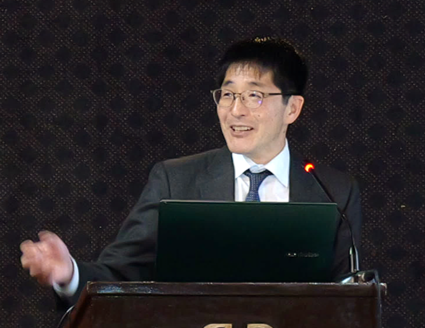 Mr. Yoshimoto Koyanagi from the Japan International Cooperation Agency (JICA) presented a case study on the successful adoption of the rotary press-in method (Gyropress Method) for a quay wall reconstruction project at Wharf No. 3 of the Port of Dakar in Senegal—a project supported by Japan’s Official Development Assistance (ODA).
Mr. Yoshimoto Koyanagi from the Japan International Cooperation Agency (JICA) presented a case study on the successful adoption of the rotary press-in method (Gyropress Method) for a quay wall reconstruction project at Wharf No. 3 of the Port of Dakar in Senegal—a project supported by Japan’s Official Development Assistance (ODA).His presentation offered a direct demonstration of how the press-in method, particularly the rotary press-in piling technique, can be effectively applied in large-scale public infrastructure under challenging geological and operational conditions. Initially planned with a traditional gravity-type quay wall, the design was modified to adopt steel pipe piles installed with rotary press-in piling machinery, enabling safe, compact, and vibration-free construction even on rocky ground.
Mr. Koyanagi shared the key design considerations and construction innovations that contributed to the project’s success, including pile optimization using frame models, countermeasures against backfill leakage and clogging, and adaptations for construction stability. Despite delays due to COVID-19, the project was completed ahead of the adjusted schedule.
This presentation not only highlighted the technical viability of press-in piling technology in West Africa, but also aligned with the seminar’s broader objective of showcasing practical applications of press-in engineering in diverse environments. It served as a concrete example of international cooperation, innovation, and technology transfer—demonstrating the real-world impact of the methods discussed throughout the seminar.
Presentation 7: Applicability of High Strain Dynamic Load Tests to Press-in Piles as Quality Control Mean: Field Records – Prof. Marawan M. Shahien
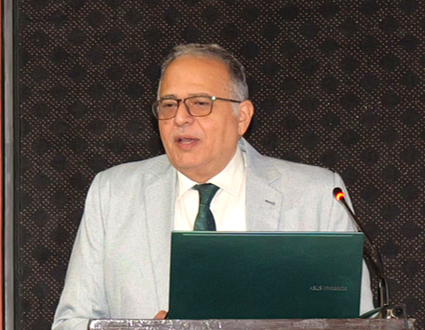 Prof. Marawan M. Shahien, Director of the IPA and Vice President for Africa of the International Society for Soil Mechanics and Geotechnical Engineering (ISSMGE), served as Chair of the seminar and presented findings from field studies on the use of high strain dynamic load testing (HSDLT) for pile foundation quality control.
Prof. Marawan M. Shahien, Director of the IPA and Vice President for Africa of the International Society for Soil Mechanics and Geotechnical Engineering (ISSMGE), served as Chair of the seminar and presented findings from field studies on the use of high strain dynamic load testing (HSDLT) for pile foundation quality control.He outlined the testing setup, instrumentation, and standards (ASTM D4945), and compared the performance of HSDLT with static load testing (SLT) through three case histories from Egyptian infrastructure projects involving driven composite piles, bored piles, and steel pipe piles.
The results showed that HSDLT generally aligned with SLT for closed-ended piles, but discrepancies arose in open-ended pipe piles, particularly when soil plugs were underdeveloped. Prof. Shahien emphasized the importance of understanding pile-soil interaction and carefully selecting predictive methods to ensure reliable results.
His presentation offered valuable insights into the applicability and limitations of dynamic testing in geotechnical practice, reinforcing the seminar’s broader message of promoting sustainable and data-informed foundation solutions across Africa.
Presentation 8: Introduction of Construction Achievements Related to Disaster Prevention, Recovery, and Renovation Using the Press-in Technology – Ms. Sayuri Tasaki
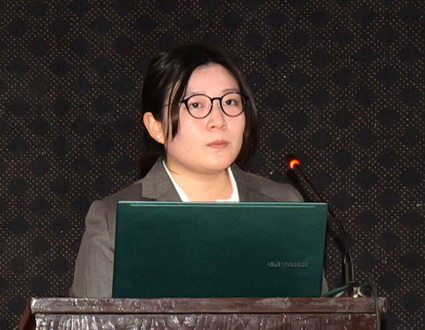 As the final oral presentation of the seminar, this session highlighted the real-world implementation of press-in piling technologies across a range of engineering challenges—serving as a practical complement to the earlier technical discussions and reinforcing the seminar’s core message of applicability and sustainability.
As the final oral presentation of the seminar, this session highlighted the real-world implementation of press-in piling technologies across a range of engineering challenges—serving as a practical complement to the earlier technical discussions and reinforcing the seminar’s core message of applicability and sustainability.Ms. Sayuri Tasaki of GIKEN SEKO CO., LTD., one of the seminar’s gold sponsors, presented an overview of the company’s achievements in Japan and abroad in the fields of disaster prevention, infrastructure recovery, and renovation using press-in methods. She began by outlining the GIKEN Group’s core philosophy and the development of press-in piling technologies, emphasizing their ability to meet urban, environmental, and seismic constraints.
Several case studies from Japan were shared, including installation of landslide prevention piles in Nagasaki, riverbank rehabilitation in Hokkaido, and post-disaster recovery projects in Ishikawa and Kagoshima following earthquakes and heavy rainfall. She also described liquefaction countermeasures implemented in coastal Kochi.
In addition, Ms. Tasaki introduced international projects—many of which were supported by Japan’s Official Development Assistance (ODA)—such as quay wall renovation in Dakar, hospital infrastructure in Cairo, bridge and drainage improvements in Bangladesh and India, and consultation for historic canal wall renovation in the Netherlands.
Her presentation concluded by positioning press-in piling technology as a globally adaptable, sustainable, and environmentally responsible solution for complex construction scenarios, echoing the broader seminar theme of promoting practical, forward-looking engineering innovation.
Video Presentation: SmartSheetPile™ – Innovative Monitoring for Sustainable Coastal Infrastructure – ArcelorMittal Sheet Piling
 As part of the seminar program, a video presentation was shared by ArcelorMittal Sheet Piling, one of the seminar’s gold sponsors. The presentation introduced SmartSheetPile, a next-generation steel sheet pile system integrated with real-time monitoring technologies to enhance the resilience and longevity of coastal and flood protection infrastructure.
As part of the seminar program, a video presentation was shared by ArcelorMittal Sheet Piling, one of the seminar’s gold sponsors. The presentation introduced SmartSheetPile, a next-generation steel sheet pile system integrated with real-time monitoring technologies to enhance the resilience and longevity of coastal and flood protection infrastructure.Delivered by Ms. Abir Gallala (Business Development Manager and Technology Specialist) and Ms. Barana Kullolli (Climate Change Officer), the presentation aligned closely with the seminar’s focus on sustainability, innovation, and practical engineering solutions. It addressed pressing climate-related challenges such as sea level rise, flooding, and coastal erosion—issues highly relevant to many countries across Africa and beyond.
The SmartSheetPile® system incorporates advanced sensors and digital twin technology to monitor key structural indicators—such as water level, soil pressure, deformation, corrosion, and impact—in real time. This enables asset owners to move toward predictive maintenance and informed decision-making while reducing dependence on manual inspection in inaccessible or hazardous environments.
By showcasing how traditional materials like steel piles can be transformed into intelligent infrastructure through digital integration, the presentation reinforced the seminar’s broader message: that technological innovation, when combined with sustainability goals, plays a crucial role in addressing global and local infrastructure needs.
▶ Video Link:
SmartSheetPile – Innovative Monitoring for Sustainable Coastal Infrastructure
Presented by ArcelorMittal Sheet Piling
Available at: https://www.youtube.com/watch?v=SRDiYGQRGXg
Conclusion and Future Directions
One of the most engaging aspects of the seminar was the dynamic question-and-answer sessions that followed each presentation. These discussions reflected not only the attendees’ strong interest in press-in piling technology, but also their active involvement in applying it across diverse regional and technical contexts.
Building on this energy and shared commitment, the seminar ultimately reinforced the importance of collaboration between academia, industry, and government in advancing sustainable, adaptable, and data-informed foundation engineering. From emerging technologies such as digital monitoring and smart infrastructure, to the practical deployment of press-in piling technology in disaster recovery and development projects, the seminar highlighted both current capabilities and future possibilities.
Closing Remarks – Dr. Andrew McNamara
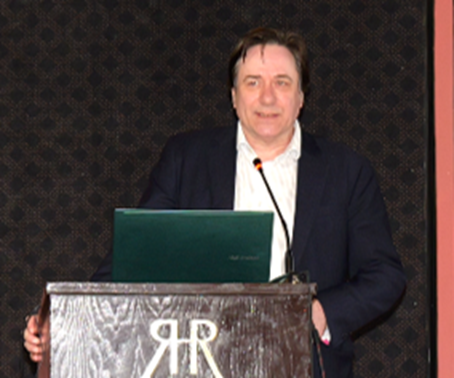 The seminar concluded on a high note with closing remarks by Dr. Andrew McNamara, Secretary General of the International Society for Soil Mechanics and Geotechnical Engineering (ISSMGE) and Vice President of IPA.
The seminar concluded on a high note with closing remarks by Dr. Andrew McNamara, Secretary General of the International Society for Soil Mechanics and Geotechnical Engineering (ISSMGE) and Vice President of IPA.Dr. McNamara expressed his enthusiasm for the potential of press-in piling technology to significantly impact sustainable infrastructure development, particularly in Africa. He emphasized the importance of integrating academic research with practical applications to solve real-world challenges, highlighting the seminar's role in advancing this agenda.
Dr. McNamara praised the collaborative efforts of all participants and stressed the importance of continuing to foster such collaborations. He pointed out that the seminar had set a robust foundation for future initiatives that could expand the application of press-in piling technology across the continent, addressing critical infrastructure needs and environmental considerations.
Reflecting on the discussions and outcomes of the seminar, Dr. McNamara called for continued dialogue and partnership among researchers, practitioners, and stakeholders. He urged attendees to maintain the momentum gained during the event and to actively participate in the evolving field of press-in engineering to ensure it meets the current and future needs of society.
These closing remarks reinforced the seminar's success and set the stage for ongoing efforts to enhance and expand the reach of press-in engineering, promising a significant impact on sustainable construction practices in Africa and beyond.
Special Acknowledgements
Special thanks were extended to the local organizers and the Tunisian engineering community for their support and hospitality.
In addition to the thoughtful preparation and dedicated participation of the speakers, the active engagement of participants from various sectors and regions greatly contributed to the seminar’s depth and impact. The strong backing of the supporting organizations lent credibility and visibility to the seminar’s mission, while the sponsors’ contributions—ranging from technical insights to operational support—were instrumental in bringing the program to life. This spirit of open dialogue and mutual exchange underscored the inclusive nature of this international gathering and was a key factor in its success.
Finally, the IPA secretariat, in reflecting on the seminar's accomplishments, would like to extend heartfelt thanks to the Honorary Chair, Chair, Co-chair, presenters, sponsors, and all participants. Their contributions, engagement, and enthusiasm were crucial in enriching the discussions, fostering new connections, and continuing to influence sustainable construction practices across Africa.
Tunisia as the Host Country: Reflections and Appreciation

The seminar was held at the Le Royal Hammamet Hotel, a tranquil and elegant venue located in the coastal city of Hammamet—known for its rich history, warm hospitality, and scenic Mediterranean views. The hotel provided a highly conducive environment for international exchange, technical dialogue, and professional networking.
Tunisia, as the host country, played a vital role in facilitating the success of this seminar. Geographically situated at the crossroads of Europe, Africa, and the Middle East, Tunisia served not only as a venue but also as a symbolic gateway for regional and global dialogue. From local logistical arrangements to the enthusiastic engagement of Tunisian engineers and institutions, the support extended throughout the event was deeply appreciated.
The International Press-in Association expresses its sincere gratitude for the cooperation of all local partners and stakeholders. It is our hope that this seminar will serve not only as a technical milestone, but also as a stepping stone toward deeper academic and professional collaboration between Tunisia, the broader African region, and the global press-in engineering community.
| << Previous | Newsletter Top | Next >> |








